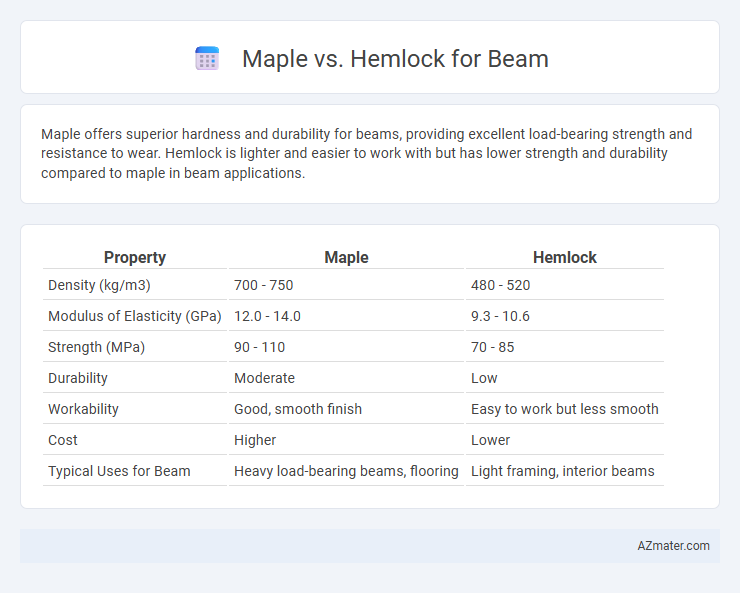Maple offers superior hardness and durability for beams, providing excellent load-bearing strength and resistance to wear. Hemlock is lighter and easier to work with but has lower strength and durability compared to maple in beam applications.
Table of Comparison
| Property | Maple | Hemlock |
|---|---|---|
| Density (kg/m3) | 700 - 750 | 480 - 520 |
| Modulus of Elasticity (GPa) | 12.0 - 14.0 | 9.3 - 10.6 |
| Strength (MPa) | 90 - 110 | 70 - 85 |
| Durability | Moderate | Low |
| Workability | Good, smooth finish | Easy to work but less smooth |
| Cost | Higher | Lower |
| Typical Uses for Beam | Heavy load-bearing beams, flooring | Light framing, interior beams |
Overview: Maple vs Hemlock Beams
Maple beams offer exceptional hardness and durability, making them ideal for structural applications requiring high load-bearing capacity and resistance to wear. Hemlock beams, while less dense, provide excellent dimensional stability and a smooth finish, making them suitable for indoor framing and decorative purposes. Both species present strong structural support, but maple's superior strength and hardness cater to heavy-duty beam requirements compared to the lighter, more workable hemlock.
Wood Properties Comparison
Maple wood boasts higher density and hardness, providing superior strength and durability for beam applications compared to hemlock. Hemlock offers greater dimensional stability and resistance to warping, making it suitable for structural use in varying climates. Both species demonstrate good load-bearing capacity, but maple's tighter grain pattern enhances its resistance to impact and wear in construction contexts.
Strength and Durability
Maple beams exhibit superior strength with a Janka hardness rating of approximately 1450, providing excellent load-bearing capacity and resistance to wear. Hemlock beams, while moderately strong with a Janka rating near 560, offer good durability in dry indoor environments but are less dense and more prone to denting compared to maple. For structural applications demanding long-term resilience and high strength, maple is typically preferred over hemlock due to its tighter grain and greater resistance to deformation.
Weight and Load-Bearing Capacity
Maple is denser and heavier than hemlock, providing superior load-bearing capacity ideal for structural beams in heavy-duty applications. Hemlock, being lighter and less dense, offers moderate strength suitable for lighter or non-critical beams where weight reduction is a priority. Choosing between maple and hemlock depends on balancing weight constraints with the required structural support for a given construction project.
Workability and Ease of Use
Maple offers exceptional workability for beams due to its fine, uniform grain and moderate hardness, allowing for smooth cutting, shaping, and fastening with minimal splintering. Hemlock, while slightly softer and easier to machine, can be more prone to warping and splitting under stress, requiring careful handling during installation. Both woods perform well structurally, but maple's superior surface finish and dimensional stability make it preferred for projects demanding precision and ease of use.
Cost and Availability
Maple beams typically cost more than hemlock due to their higher density and durability, making them a preferred choice for structural applications requiring strength. Hemlock is generally more affordable and widely available in regions like North America, favored for its lightweight nature and ease of handling. Both woods differ in availability based on geographic location, with hemlock often being more accessible and cost-effective for budget-conscious projects.
Aesthetic Considerations
Maple beams offer a light, creamy appearance with a smooth, consistent grain that enhances modern and minimalist interiors. Hemlock beams exhibit a warm, reddish-brown hue featuring a straight, pronounced grain pattern that complements rustic and traditional designs. Choosing between maple and hemlock depends on the desired aesthetic impact and the architectural style of the space.
Environmental Impact
Maple beams offer a lower environmental impact due to their faster growth rate, supporting sustainable forestry practices and carbon sequestration. Hemlock, while durable, grows more slowly, which can lead to longer harvesting cycles and greater ecological disturbance. Selecting maple for beams contributes to reduced habitat disruption and improved resource regeneration compared to hemlock.
Common Applications in Construction
Maple beams are favored in construction for their high density and strength, making them ideal for flooring, cabinetry, and decorative architectural elements that require both durability and aesthetic appeal. Hemlock beams are commonly used in structural framing, roof trusses, and general framing due to their moderate strength, straight grain, and cost-effectiveness. Both species offer reliable performance, with maple preferred for visible, finish-quality applications and hemlock chosen for load-bearing components where economy and workability are priorities.
Choosing the Right Beam Material
Maple offers exceptional strength and durability, making it an ideal choice for beams requiring high load-bearing capacity and resistance to wear. Hemlock, while generally lighter and more cost-effective, provides good structural support but is more susceptible to splitting and may require additional treatment for longevity. Selecting between maple and hemlock depends on the specific project demands, balancing factors such as strength, weight, durability, and budget constraints.

Infographic: Maple vs Hemlock for Beam
 azmater.com
azmater.com